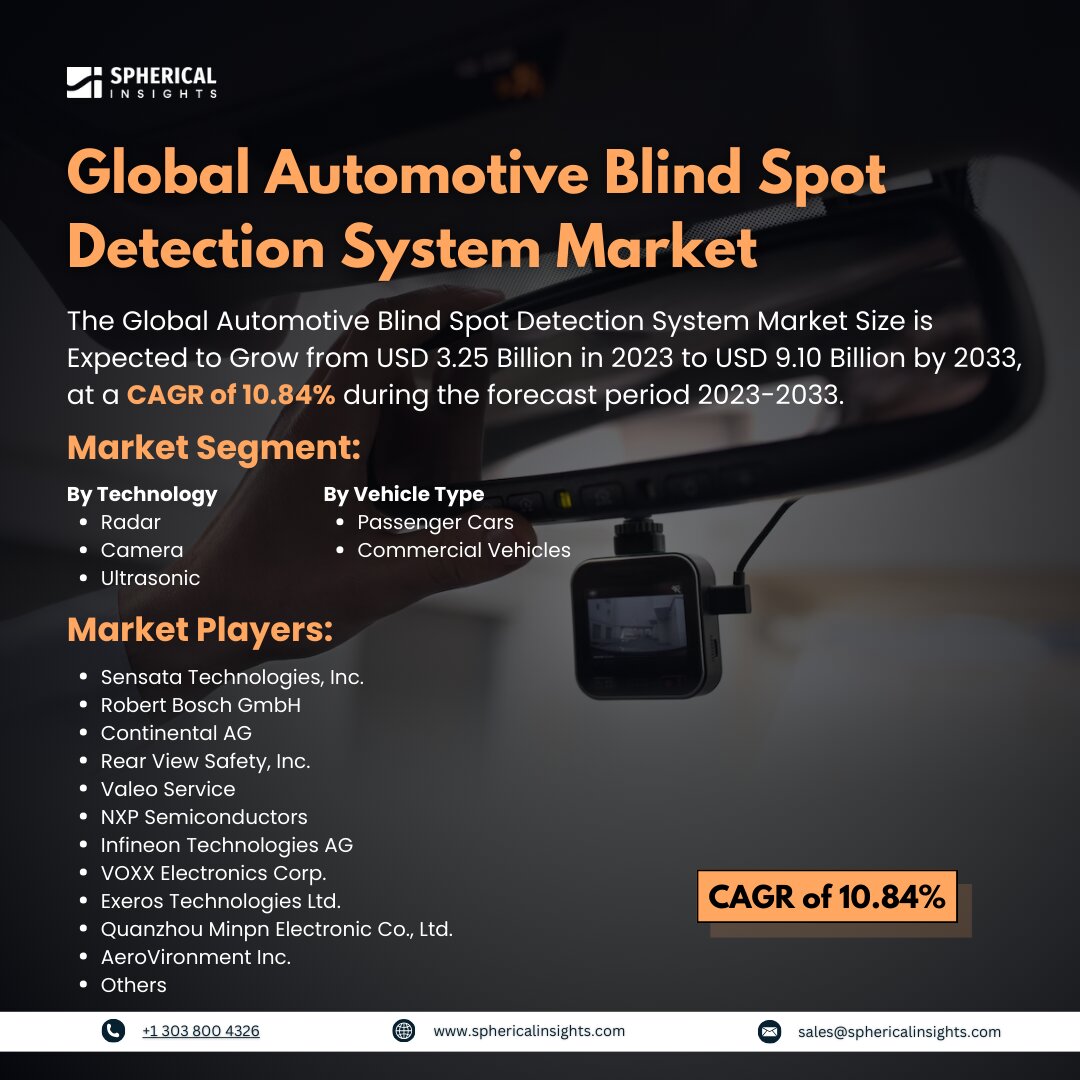Global Automotive Blind Spot Detection System Market Size to worth USD 9.10 Billion by 2033
According to a research report published by Spherical Insights & Consulting, the Global Automotive Blind Spot Detection System Market Size is Expected to Grow from USD 3.25 Billion in 2023 to USD 9.10 Billion by 2033, at a CAGR of 10.84 % during the forecast period 2023-2033.
Browse key industry insights spread across 210 pages with 110 Market data tables and figures & charts from the report on the Global Automotive Blind Spot Detection System Market Size, Share, and COVID-19 Impact Analysis, By Technology (Radar, Camera, and Ultrasonic), By Vehicle Type (Passenger Cars and Commercial Vehicles), and By Region (North America, Europe, Asia-Pacific, Latin America, Middle East, and Africa), Analysis and Forecast 2023 – 2033.
The automotive blind spot detection system market is a critical segment within the advanced driver assistance systems (ADAS) industry, designed to enhance vehicle safety by reducing the risk of collisions caused by blind spots. These systems utilize radar sensors, cameras, and ultrasonic technology to detect vehicles or obstacles in adjacent lanes and alert drivers through visual or auditory warnings. The increasing adoption of autonomous and semi-autonomous vehicles, along with stringent government regulations mandating vehicle safety features, is significantly driving market expansion. The growing consumer awareness regarding road safety, coupled with advancements in sensor technology and artificial intelligence, is further contributing to market growth. The rising integration of ADAS features in mid-range and economy vehicles due to regulatory policies and industry competition is expected to accelerate the adoption of blind spot detection systems. However, high installation costs and the complexity of integrating these systems into existing vehicle architectures pose challenges to market penetration.
The radar segment accounted for the highest share in 2023 and is expected to grow at a significant CAGR during the forecast period.
Based on the technology, the automotive blind spot detection system market is divided into radar, camera, and ultrasonic. Among these, the radar segment accounted for the largest share in 2023 and is expected to grow at a significant CAGR during the forecast period. This dominance is attributed to radar's high accuracy and reliability in detecting objects in a vehicle's blind spots under various environmental conditions. Radar sensors are capable of providing precise distance and speed measurements, making them a preferred choice for blind spot detection applications.
The passenger cars segment accounted for the largest share in 2023 and is expected to grow at a significant CAGR during the forecast period.
Based on the vehicle type, the automotive blind spot detection system market is classified into passenger cars and commercial vehicles. Among these, the passenger cars segment accounted for the largest share in 2023 and is expected to grow at a significant CAGR during the forecast period. This dominance is attributed to the rising consumer demand for advanced safety features, increasing vehicle production, and stringent safety regulations mandating the integration of driver assistance systems in passenger vehicles. The widespread adoption of blind spot detection systems in mid-range and luxury passenger cars further contributed to the segment’s substantial market share.
Asia-Pacific is estimated to hold the greatest automotive blind spot detection system market share over the forecast period.
Asia-Pacific is estimated to hold the greatest automotive blind spot detection system market share over the forecast period. This growth is attributed to the automotive industry that is growing in the region, coupled with an increase in disposable income and urbanization. These will continue to increase vehicle ownership and demand for sophisticated safety features. Moreover, the trend toward electric and autonomous vehicles further enhances the demand for more sophisticated safety technologies in the region.
North America is predicted to have the fastest CAGR growth in the automotive blind spot detection system market over the forecast period. In North America, especially in the U.S. and Canada, the automotive blind spot detection system is growing due to factors such as high demand for advanced safety features and stringent regulations by the governments. The highly developed automotive market in the region, with key players from various countries, triggers innovation and the adoption of ADAS solutions, which encourages the growth of this market.
Competitive Analysis
Major key players in the automotive blind spot detection system market are Sensata Technologies, Inc., Robert Bosch GmbH, Continental AG, Rear View Safety, Inc., Valeo Service, NXP Semiconductors, Infineon Technologies AG, VOXX Electronics Corp., Exeros Technologies Ltd., Quanzhou Minpn Electronic Co., Ltd., AeroVironment Inc., and others.
Key Target Audience
- Market Players
- Investors
- End-users
- Government Authorities
- Consulting And Research Firm
- Venture capitalists
- Value-Added Resellers (VARs)
Market Segment
This study forecasts global, regional, and country revenue from 2023 to 2033. Spherical Insights has segmented the automotive blind spot detection system market based on the below-mentioned segments:
Global Automotive Blind Spot Detection System Market, By Technology
Global Automotive Blind Spot Detection System Market, By Vehicle Type
- Passenger Cars
- Commercial Vehicles
Global Automotive Blind Spot Detection System Market, By Regional Analysis
- North America
- Europe
- Germany
- UK
- France
- Italy
- Spain
- Russia
- Rest of Europe
- Asia Pacific
- China
- Japan
- India
- South Korea
- Australia
- Rest of Asia Pacific
- South America
- Brazil
- Argentina
- Rest of South America
- Middle East & Africa
- UAE
- Saudi Arabia
- Qatar
- South Africa
- Rest of the Middle East & Africa



